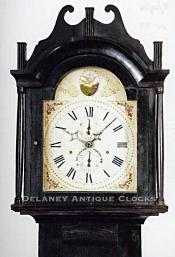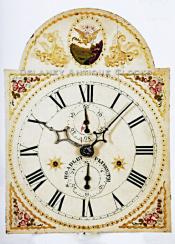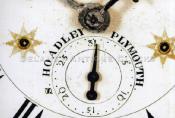Silas Hoadley, Plymouth, Connecticut. A grain-painted tall case clock. VV-99.
This is an excellent example of a wooden works tall clock made by Silas Hoadley of Plymouth, Connecticut.
The construction of this wooden geared tall clock movement is typical of the standard form that one would expect from this prolific Clockmaker. The plates used in the construction of this movement are made from oak. The movement is a standard two-train design. Both of which are powered by weights. The weights are raised by pulling on cords inside the case. Because the movement is designed to run for approximately 30 hours, this should be done once a day. The strike train features a count wheel striking system. The count wheel is located on the back plate. This clock will strike each hour on a cast iron bell mounted above the movement.
The arched wooden dial is nicely paint-decorated. It is a standard size. All of the various decorations are framed in raised gesso patterns that are highlighted in gilt paint. The spandrels are decorated with colorful floral themes. In the arch is the E. Pluribus Unum symbol of the American Eagle with outstretched wings, clutching a number of arrows and olive branches in its claws. The American shield is in front of the eagle's breast. The thirteen stars, one star for each state, surround the bird's head. This is a very powerful symbol of our new nation. It is a symbol of unity. The hours are marked with Roman hour numerals. This dial also displays the seconds and calendar day via subsidiary hands and dials located within the time track.
The case is constructed in New England white pine. It is paint-decorated in black and red. The paint pattern used simulates the grain of mahogany. This is in very good original condition. There are some areas of minor loss. These are somewhat confined to the lower right side of the hood. A coat of shellac applied over the paint has now nicely textured into a surface reminiscent of an alligator's skin in some areas. This case stands on a simple bracket base with shaped cutout feet. The waist is long and narrow, featuring a rectangular-shaped waist door. The door provides access to the interior of the clock. This clock is wound from this location. The bonnet features a New England-style fretwork pattern in the form of arches. Three wooden finial plinths or chimneys support it. The bonnet door is fitted with glass. This door is flanked by smoothly turned bonnet columns that are free-standing.
This example stands approximately 86 or 7 feet 2 inches tall to the top of the arches. The lower bonnet molding, exhibiting the largest dimensions of the case, is 18.75 inches wide and 10 inches deep. This clock was made circa 1815.
Silas Hoadley, a prominent figure in the world of clockmaking, was born in 1786 and passed away in Plymouth, CT in 1870. He began his journey in clockmaking under the tutelage of his uncle Samuel, and by 1808, he was already making clocks. He later became associated with renowned clockmakers Eli Terry and Seth Thomas, eventually purchasing their shares of the business. Hoadley was known for his innovative designs, such as the 'Upside down' style used in a number of shelf clocks. In 1849, he retired a wealthy man, leaving behind a legacy of exceptional craftsmanship.
Inventory number VV-99.
Silas Hoadley was born in Bethany, Connecticut, on January 31, 1786. He was the son of Ammi Hoadley and Amy (Thompson) Hoadley. He first apprenticed as a joiner to his uncle Calvin Hoadley. Along with Seth Thomas, he was hired in about 1808 by Eli Terry at the age of 21 to set up and work at Terry's Ireland factory. Shortly after Terry's Porter Contract was satisfied, he and Seth Thomas bought the factory from Terry. Thomas & Hoadley continued to make tall clock movements until 1813, when he purchased Thomas's business shares. He transitioned to shelf clocks, manufacturing movements of his own design. The "Upside down" style is one of the more unique examples. In the late 1830s, he transitioned to manufacturing brass movements. He retired in 1849 as a wealthy man. Silas Hoadly died on December 28, 1870, in Plymouth, Conn.
















